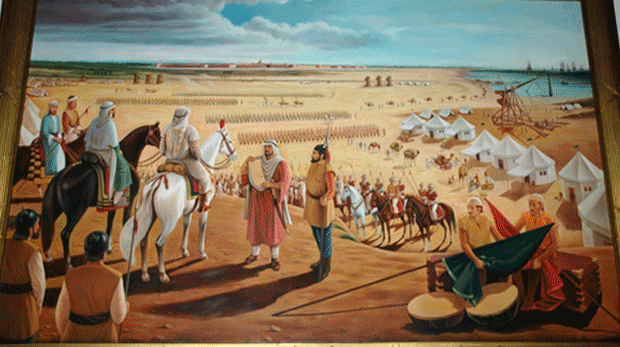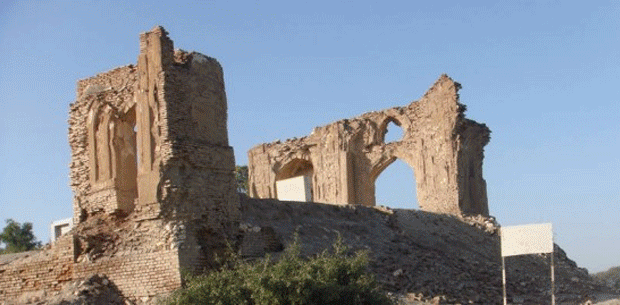Muhammad bin Qasim Al-Thaqafi was an Umayyad general who conquered the Sind and Punjab regions along the Indus River (now a part of Pakistan) at the age of seventeen. The conquest of Sind and Punjab began the Islamic era in South Asia and continues to lend the Sind province of Pakistan the nickname Bab-e-Islam (The Gateway of Islam).
He was born and raised in the city of Taif (in modern-day Saudi Arabia). A member of the Thaqafi tribe of the Ta'if region, Muhammad bin Qasim's father was Qasim bin Yusuf who died when Muhammad bin Qasim was young, leaving his mother in charge of his education. Umayyad governor Al-Hajjaj Ibn Yusuf Al-Thaqafi, Muhammad bin Qasim's paternal uncle, was instrumental in teaching Muhammad bin Qasim about warfare and governance. Under Hajjaj's patronage, Muhammad bin Qasim was made governor of Persia, where he succeeded in putting down a rebellion.
|
Conquer of Sind
During those times, some Muslim traders living in Ceylon died and the ruler of Ceylon sent their widows and orphans back to Baghdad. They made their journey by sea with pilgrims. The King of Ceylon also sent many valuable presents for Walid and Hajjaj. As the eight-ship caravan passed by the seaport of Daibul, Hindu pirates looted it and took the women and children prisoner. When news of this attack reached Hajjaj, he demanded that Dahir return the Muslim captives and the looted items. He also demanded that the culprits be punished. Dahir replied that he had no control over the pirates and was, therefore, powerless to rebuke them. On this Hajjaj decided to invade Sind. Two small expeditions sent by him failed to accomplish their goal. Thus, in order to free the prisoners and to punish the guilty party, Hajjaj decided to undertake a huge offensive against Dahir, who was patronizing the pirates. The reason for attack was Raja Dahir's policies.
When Muhammad bin Qasim began the invasion of Debal, the ruler of Sind Raja Dahir was staying in his capital Alor (Nawabshah) about 500 kms away. Debal was in the charge of a governor with a garrison of four to six thousand Rajput soldiers and a few thousand Brahmans, and therefore Raja Dahir did not march to its defense immediately. All this while, the young invader was keeping in close contact with Hajjaj, soliciting the latter’s advice even on the smallest matters. So efficient was the communication system that letters were written every three days and replies were received in seven days, so that the campaign was virtually directed by the veteran Hajjaj ibn Yusuf himself. When the siege of Debal had continued for some time a defector informed Muhammad bin Qasim about how the temple could be captured.
Thereupon the Arabs, planting their ladders stormed the citadel-temple and swarmed over the walls. As per Islamic injunctions, the inhabitants were invited to accept Islam. The carnage lasted for three days. The temple was razed and a mosque built. Muhammad bin Qasim laid out a Muslim quarter, and placed a garrison of 4,000 in the town. As this was the pattern of all future sieges and victories of Muhammad bin Qasim as indeed of all future Muslim invaders of sub-continent - it may be repeated. Inhabitants of a captured fort or town were invited to accept Islam. At Ar-rur, he was met by Dahir's forces and the eastern Jats in battle. Dahir died in the battle, his forces were defeated and a triumphant Muhammad bin Qasim took control of Sind.
|
Character sketch of Muhammad bin Qasim
The military and the administrative success of Muhammad bin Qasim form one of the most brilliant chapters in the history of the Muslim rulers of Indo-Pakistan. He was a born leader and a man of versatile genius. He was a poet, a patriot, a statesman and an accomplished administrator. His tender age, impressive figure, his dauntless courage and noble bravery, his brilliant victories in battles and wise method of administration and lastly his sudden and tragic end make the story of his short and illustrious life one of the romances of history. He was strong against opponents and tender-hearted to his friends. According to al-Marzubani, Muhammad bin Qasim was one of the great men of all times.
An able General
The army of Raja Dahir was inferior in technical skill and his commanders were inferior in generalship, Muhammad bin Qasim, a young man of 17 was an intrepid and skilful general, and the success of the Arabs in Sind was largely due to his able generalship. He was not only a great warrior and conqueror but also a good administrator. The administration introduced by him leads us to believe that he possessed great experience in the art of administration. Some of the temples were no doubt destroyed during the days of war, but that was a temporary phase, for the destruction of the temple was due not to religious bigotry or fanaticism but to the fact that the temples were the repositories of India’s age long accumulated wealth.
|
He adopted kind and conciliatory policy towards the subject. The Brahmins were permitted to perform their rites and ceremonies in the manner prescribed by their religion. He granted the population of Sind the right to life and property in lieu of their submission and willingness to pay taxes to the Muslim administrator.
Far sighted statesman
Muhammad bin Qasim was a far-sighted statesman and great politician. He did not disturb the existing system of administration in Sind. He placed the entire machinery of internal administration in the hands of the natives. The people, who had occupied key posts in the time of Dahir, were expected to know all about the land. According to Chach Nama, Reposing full confidence in them, Muhammad bin Qasim entrusted them with high offices and placed all important affairs of the place in their hands".
|











No comments